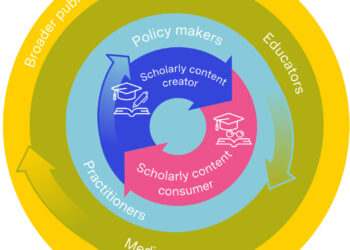This is a bit off-topic for this blog, but of interest to scholarly publishers, and I found myself doing a lot of thinking and digging about this for some reason. The announcement by Rockefeller Press that they will leave copyright with authors, let authors do what they will with their work, allow “noncommercial” entities to adapt and use things, and put works effectively in the public domain after six months has me a bit perplexed. Their policy stipulates that after six months, works will be available under Creative Commons Attribution-NonCommercial-ShareAlike provisions.
Now, I’ve always been skeptical about the assertion that authors want their copyright. I predict that once some important materials get abused or over-used, and an author or author group finds out what it takes to protect, defend, prosecute, and/or enforce their copyright, and learns the difference between statutory and actual damages and how they did or didn’t position themselves properly for either, and learns about the varied copyright laws at play internationally and in various countries, suddenly having a publisher fighting on your side won’t look so bad.
Beyond this, there is a perplexing and, I think, maybe not completely thought-out part of the policy regarding mirror web sites. It reads:
No Mirror Sites. The user may not create, compile, publish, host, enable, or otherwise make available a mirror site of the RUP web site, any of its constituent journal web sites (The Journal of Cell Biology, The Journal of Experimental Medicine, and The Journal of General Physiology), or any subset of the RUP or journal web sites. A “mirror site” is a web site that contains the same content as a parent web site but is located at a different geographic location from the parent site. This prohibition applies regardless of the commercial or non-commercial nature of the mirror site.
Now, I’m sure I’m taking this way too far, but did I just violate it? After all, I just published a “subset of the RUP or journal web sites” on another site, right? If Rockefeller journals are crawled by Google, doesn’t the mirror of RUP content in Google violate this clause as well? What about an RSS feed? A gadget on iGoogle?
And there’s yet another perplexing aspect. As the press release states, “Citing the growing demand from the public” . . . have you tried to read these articles? They’re pretty hard sledding for even a layperson like me who has edited scientific prose professionally. The issue isn’t access. It’s that these are written for scientists in the upper echelons. You can make these things free until the cows come home, they will become no more understandable or comprehensible to the non-specializing scientist, forget about “the public.”
Finally, the term “noncommercial” isn’t as unassailable as you might think. While I’m sure the intent is to prevent direct resale of content, there are active discussions about what “noncommercial” actually means. Is a major private university with an endowment of $X billion and real assets greater than those of most corporations, even most countries, not a commercial venture? Even Creative Commons has trouble with this one. In their licenses, they tell you what commercial uses are, and define noncommercial uses as things that aren’t commercial. But, in a blog entry about trying to deal with this issue in Sweden, they state, “This is a negative definition, limiting the scope of rights granted through the license agreement. Still, we can not be sure what non-commercial is supposed to mean.” I searched for a good meaning, but it’s pretty hard to come by. The blogger above goes on:
I suspect that Creative Commons is trying to make sure no “unjust” or “unfair” use of the works will occur. I can imagine that Creative Commons’ chairman professor Lawrence Lessig would suffer from severe nightmares, should for example the Disney Corporation be able to capture and kidnap and make commercial use of content licensed as Attribution-NonCommercial-ShareAlike 2.0. Even though preventing such “unfair” use of works may be the purpose of the “non-commercial” clause, it is not fully clear what uses of works is restricted, as pointed out above. It is probably that from the public’s view a huge amount of uses shall be restricted if “non-commercial” use of the works is prohibited. Should you for example be able to put a number of Attribution-NonCommercial-ShareAlike 2.0-licensed weblogs’ RSS-feeds on a web-page packed with advertisements?
This is a can of worms, but it needs to fully addressed. The legal definition of “commercial” is not clear. There are not precedents where the meaning of “commercial” has been tried. Yet. But one might suspect that the interest of profit or other market advantage will matter in a legal perspective on the word “commercial”. However, when interpreting the license agreement, the courts will also look on what the parties did reasonably expect and what the circumstances concerning the formation of the contract were and how the parties have acted on the market. Hence, the word “commercial” may even have different meanings in different cases when interpreting the same license. If, for example, one author tells a licensee that he may use the work for educational purposes in his private school, this will make the use of the work permissable even though others should interpret the use as commercial use.
There you have it. While Rockefeller University Press certainly has its heart in the right place, I’m uncertain that they are accomplishing what they intended as far as service to authors, protecting materials from abuse, and increasing access. Some parts of the policy may have an unintended chilling effect in the age of Web 2.0, the noncommercial aspect leaves plenty of doors open, accessibility has more dimensions than just the ability to get something, and authors may not benefit in the long run by keeping their copyrights.
Or am I missing something?



